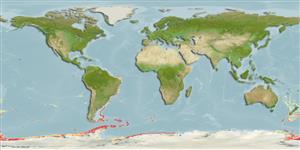Common names from other countries
Classification / Names / Names
Nomes comuns | Sinônimos | Catalog of Fishes (gen., sp.) | ITIS | CoL | WoRMS
Environment: milieu / climate zone / depth range / distribution range
Ecologia
; intervalo de profundidade 552 - 953 m (Ref. 7659). Polar; 46°S - 76°S, 163°W - 172°E
Southeast Pacific, Southwest Atlantic and the Antarctic.
Length at first maturity / Tamanho / Peso / Idade
Maturity: Lm ? range ? - ? cm Max length : 0.5 cm SHL macho/indeterminado; (Ref. 7659)
Life cycle and mating behavior
Maturidade | Reprodução | Desova | Ovos | Fecundidade | Larvas
Members of the class Bivalvia are mostly gonochoric, some are protandric hermaphrodites. Life cycle: Embryos develop into free-swimming trocophore larvae, succeeded by the bivalve veliger, resembling a miniature clam.
MarineSpecies.org. 2050. (Ref. 3477)
Status na Lista Vermelha da IUCN (Ref. 130435)
Status no CITES (Ref. 108899)
Not Evaluated
Not Evaluated
Perigo para os humanos
Harmless
Uso pelos humanos
| FishSource |
Ferramentas
Mais informação
Nomes comunsSinônimosPredadoresReproduçãoMaturidadeDesovaFecundidadeOvosDesenvolvimento dos ovos
Idade/TamanhoCrescimentoComprimento-pesoComprimento-comprimentoMorfologiaLarvasAbundância
Fontes da internet
Estimates based on models
Preferred temperature
(Ref.
115969): -0.7 - 5.1, mean 0.8 (based on 183 cells).
Vulnerabilidade
Low vulnerability (10 of 100).
